Gardening is a fulfilling hobby that allows us to connect with nature and create beautiful spaces. Whether you have a large backyard or a small balcony, this guide will provide you with general gardening tips to help you get started.
Choosing the right plants is crucial, especially for beginners. Start with plants that are suitable for your area’s climate and soil conditions. Annuals are perfect for adding bursts of color and are relatively easy to care for, while perennials and biennials add beauty and structure to your garden. Consider their specific requirements, such as sunlight, water, and soil conditions, to ensure their success.
Preparing the soil is a crucial step in creating a successful garden. Conduct a soil test to determine its nutrient levels and pH balance. This will help you make informed decisions about soil amendments, such as compost and organic matter, to enrich the soil. Good drainage is also essential to prevent waterlogged roots and root rot.
Proper planting techniques are important for the health of your plants. Learn how to space them correctly, the proper depth for planting seeds, seedlings, and potted plants, and the importance of watering. Regular maintenance tasks, such as watering techniques, fertilization, pruning, and pest control, are also necessary to keep your garden thriving.
Consider starting an edible garden to enjoy the benefits of growing your own food. Select plants that thrive in your climate and location, and provide them with the right amount of sunlight and water. Start small and gradually expand your garden as you gain more experience.
Remember to observe your plants, learn from your mistakes, and adapt your gardening practices accordingly. Keeping a gardening journal can help you track your progress and make wise choices. Connect with other gardeners for guidance and community support.
Finally, enjoy the journey of gardening. Take pleasure in seeing your plants grow and thrive, and savor the rewards of harvesting your own fresh produce. With perseverance and a little patience, you can unleash your green thumb and create a flourishing garden.
Key Takeaways:
- Choose the right plants for your area’s climate and soil conditions
- Conduct a soil test to determine nutrient levels and pH balance
- Learn proper planting techniques and regular maintenance tasks
- Consider starting an edible garden for the benefits of growing your own food
- Observe your plants, keep a gardening journal, and connect with other gardeners for guidance and support
- Enjoy the journey of gardening and savor the rewards of a flourishing garden
Choosing the Right Plants for Your Garden
Start by choosing the right plants for your garden, whether they are annuals that complete their life cycle in one season, perennials that come back year after year, or biennials that take two years to complete their life cycle. Once you have decided on the type of plant, consider the amount of sunlight and water it needs, and make sure your soil is suitable for its growth.
Soil preparation is crucial for a healthy garden, so conduct a soil test to determine the nutrient levels and pH balance. Based on the results, you can determine if your soil needs amendments such as compost or organic matter to improve its structure and fertility.
When choosing plants, consider their height and width when fully grown, to ensure they fit in your garden design. Decide if you want to create a focal point with a large plant or fill empty spaces with smaller ones.
| Plant Type | Description | Examples |
|---|---|---|
| Annuals | Complete their life cycle in one growing season | Marigolds, Petunias, Zinnias |
| Perennials | Live for multiple growing seasons | Lavender, Daylilies, Hostas |
| Biennials | Take two years to complete their life cycle | Forget-Me-Nots, Hollyhocks, Foxgloves |
Proper planting techniques are also important for the growth and health of your plants. Dig a hole twice the size of the root ball, and loosen the soil at the bottom of the hole to encourage root growth. After planting, water thoroughly and add a layer of mulch to retain moisture and regulate soil temperature.
Maintenance practices like fertilization, pruning, and pest control are also essential for the health of your plants. Use organic fertilizers to promote growth and improve soil quality without harming the environment. Prune your plants regularly to remove dead or diseased branches and promote new growth. Use organic pest control methods to prevent damage by insects or other animals.
Remember, gardening is an ongoing journey that requires care and attention. Learn from your experiences and enjoy the process of nurturing your plants to create a beautiful and thriving garden.
Soil Preparation for a Healthy Garden
Soil preparation is key for a healthy garden, so conduct a soil test to determine the nutrient levels and pH balance and add soil amendments like compost or organic matter to improve fertility and drainage. A healthy garden requires good drainage, so poorly draining soil may lead to waterlogged roots and root rot.
But, how do we know whether our soil is fertile and well-draining? Conducting a soil test can provide valuable insights into the condition of the soil. Soil testing can determine the nutrient levels and pH balance of the soil, which can guide decisions on fertilization and soil amendments. A soil test can be done by a professional or with DIY kits available at most garden centers.
Once you have the results of the soil test, you can add soil amendments like compost, organic matter, and sand to improve the soil’s structure, fertility, and drainage. Compost and organic matter are great options as they also encourage beneficial earthworms and micro-organisms to thrive in the soil.
Good drainage is essential for healthy plant growth, the addition of sand or grit to heavy clay soil can help with drainage while the addition of organic matter to sandy soil can help improve water retention. Soil should be adequately moistened before planting to ensure the seedlings have the necessary moisture to grow healthily.
Remember, gardening is a learning process, and mistakes are inevitable. With a little perseverance and the right techniques, anyone can develop a green thumb and enjoy the wonders of organic gardening.
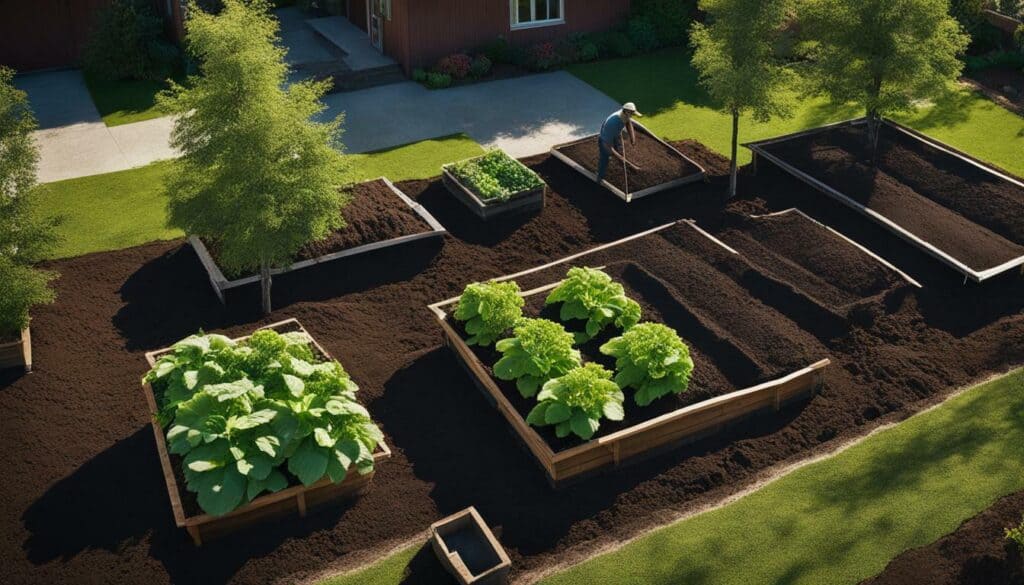
“Organic gardening is not just a hobby, it’s a lifestyle. It is not only about growing plants, but it is also about building a healthy ecosystem where plants, animals, and microorganisms can thrive together in harmony.” – Unknown
Proper Watering Techniques for a Healthy Garden
Don’t forget about proper watering techniques, maintenance tips, fertilization, pruning, and pest control to keep your garden thriving throughout the season. When it comes to maintaining a healthy garden, watering plays a significant role. Here are some tips to get you started:
| Tip | Description |
|---|---|
| Water deeply but sparingly | It’s better to water your garden deeply and less frequently rather than shallowly and more often. This helps encourage the roots to grow deeper, which makes them more resistant to drought conditions. Watering too often can cause root rot and other moisture-related problems. |
| Allow soil to dry slightly between waterings | It’s important to let the top inch or two of soil dry out between waterings. This helps to prevent excess moisture and reduces the risk of fungal disease. To check if the soil is dry, stick your finger into the soil. If it feels dry to the touch, it’s time to water. |
| Water at the right time of day | Watering in the morning is best, as the plants have all day to dry off before the sun sets. If you water at night, the plants remain moist, which increases the risk of fungal disease. |
| Use mulch | Mulch helps retain soil moisture by reducing evaporation. Apply a layer of mulch around your plants, but avoid piling it up against the stems, as this can cause rot. |
| Monitor and adjust | Regularly monitor your garden for signs of over or underwatering. Adjust your watering practices as needed based on the weather and soil conditions. Use a rain gauge to keep track of how much water your garden is receiving. |
By following these watering techniques, you can help ensure that your garden remains healthy and vibrant throughout the growing season. Remember, good gardening practices begin with proper watering!
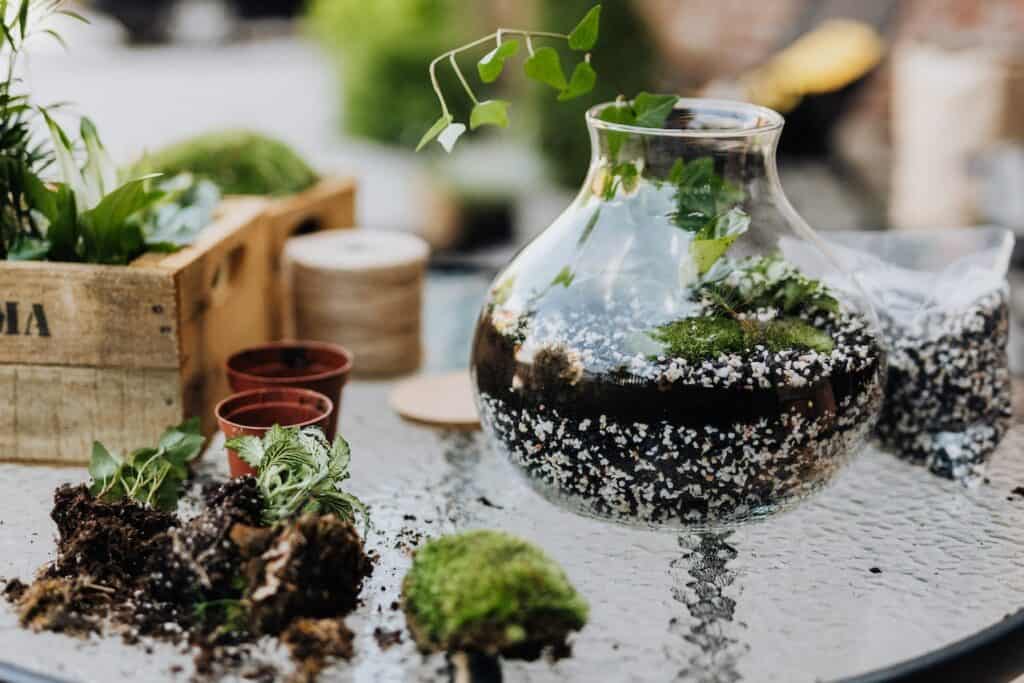
Fertilization and Pruning Tips
If you want your garden to flourish, fertilization and pruning are essential tasks that should not be overlooked. Proper fertilization can help enrich the soil and provide the necessary nutrients for healthy plant growth. Before adding any fertilizer, it is important to conduct a soil test to determine the pH balance and nutrient levels. This will help you choose the right fertilizer for your garden’s specific needs.
Soil amendments such as compost, manure, peat moss, and leaf mold are great options to enrich the soil and improve its fertility. These organic materials will help retain moisture and improve drainage, which are crucial for plant growth.
Along with fertilization, pruning is also a critical aspect of garden maintenance. Regular pruning promotes healthy growth and enhances air circulation. Dead or diseased branches should be pruned to prevent the spread of disease and encourage new growth. Deadheading, or removing spent flowers, is another important pruning technique that encourages more blooms and extends the flowering season.
It is important to fertilize and prune according to the specific needs of the plants in your garden. Some plants require more frequent fertilization than others, while some may not require much pruning at all. By understanding the specific needs of your plants, you can create a thriving garden that will flourish throughout the season.
Don’t forget about proper watering techniques, maintenance tips, fertilization, pruning, and pest control to keep your garden thriving throughout the season.
Pest Control Methods for a Thriving Garden
Don’t forget about proper watering techniques, maintenance tips, fertilization, pruning, and pest control to keep your garden thriving throughout the season. Pest control is essential for maintaining a healthy garden and preventing insects and diseases from damaging your plants. Organic gardening methods are a great way to protect your plants while minimizing the impact on the environment.
When starting a garden, it’s important to choose the right plants that are suitable for your gardening zone and skill level. Some plants are easier to grow and require less maintenance than others. Preparing the soil is crucial for plant growth, and conducting a soil test can help you determine nutrient levels and pH balance. Soil amendments such as compost, manure, peat moss, and leaf mold can improve soil structure and provide essential nutrients for plant growth.
| Pest Control Methods | Description |
|---|---|
| Beneficial Insects | Introducing beneficial insects such as ladybugs and praying mantises to your garden can help control harmful pests. |
| Neem Oil | Neem oil is a natural pesticide that can be used to control a variety of pests, including aphids, spider mites, and whiteflies. |
| Cultural Control | Regular monitoring and early action against disease and pests can prevent widespread damage to plants. |
Regular watering and maintenance are also important for a healthy garden. Overwatering can lead to root rot, while underwatering can cause plants to wilt and die. Fertilization and pruning promote plant growth and maintain the overall health of your garden. Using organic fertilizers such as fish emulsion or compost tea can provide essential nutrients without harmful chemicals. Pruning can help remove dead or diseased branches, improve air circulation, and promote new growth.
Companion planting is another method that can benefit your garden. Planting certain types of plants together can help repel pests, attract beneficial insects, and improve soil fertility. Mulching can help retain moisture, suppress weeds, and regulate soil temperature.
Gardening requires observation, patience, and learning from mistakes. Keeping a gardening journal and seeking guidance from experienced gardeners can be beneficial. By following these pest control methods and taking care of your garden with attention to detail, you can enjoy the rewards of a thriving garden.
The Joy of Indoor Gardening
Are you looking for a way to bring the beauty of nature into your home? Indoor gardening is a great way to create your own green oasis, no matter how big or small your living space is. With the right plants and equipment, you can design your own lush garden and enjoy the many benefits of gardening all year round.
Choosing the right plants is the first step to creating a thriving indoor garden. From colorful annuals to long-lasting perennials, there are many options to choose from. Some of the best plants for indoor gardening include herbs, microgreens, and some vegetables. Determine your specific growing zone and choose plants that will thrive in the conditions you can offer. Providing sufficient sunlight, water, and soil amendments is crucial to the long-term health of your plants.
Soil preparation is another essential aspect of indoor gardening. Conduct soil tests to determine nutrient levels and pH balance, and add soil amendments such as compost and organic matter to improve soil fertility and drainage. Proper techniques for planting seeds, seedlings, and potted plants are important for a successful garden.
Don’t forget about proper watering techniques, maintenance tips, fertilization, pruning, and pest control to keep your garden thriving throughout the season. These ongoing care tasks are essential for maintaining plant health and promoting growth. Companion planting and acceptance of mistakes in your gardening journey can also help to achieve success.
Indoor gardening is not limited to just one season. With proper care, you can enjoy the beauty and benefits of your garden all year round. Joining community groups or online forums can provide guidance and support for all gardeners. Making seasonal plans and enjoying the process of gardening are important aspects of the joy of indoor gardening.
So, whether you have a spacious backyard or a cozy balcony, indoor gardening is a great way to bring the beauty of nature indoors and enjoy the many benefits of gardening all year round. Start your gardening journey today!
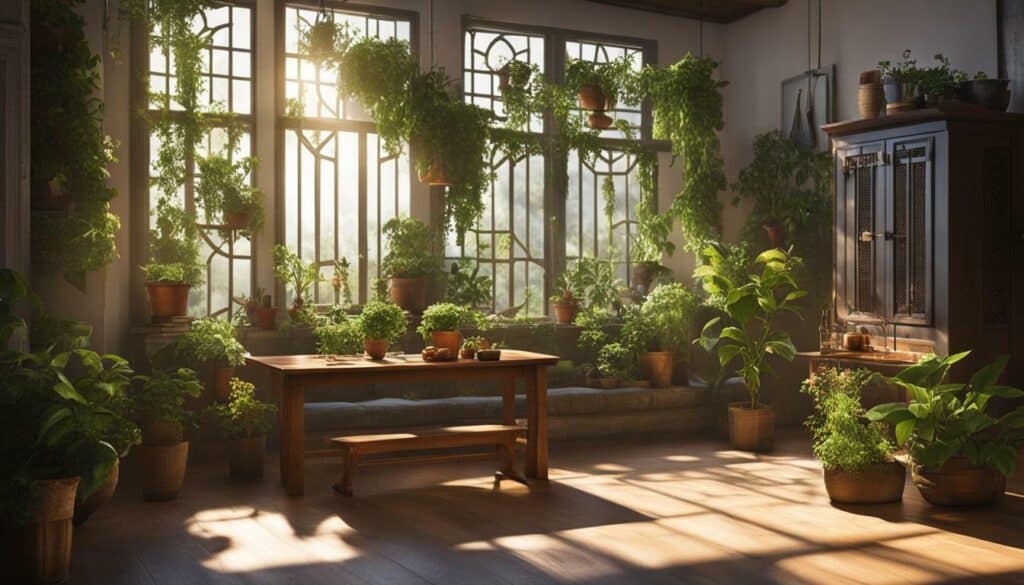
Exploring Vegetable Gardening
Do you want to grow your own fresh produce and connect with nature? Vegetable gardening is a fulfilling and rewarding hobby that allows you to do just that. To get started, it is important to choose the right plants for your garden, taking into account factors such as sunlight, water, and soil conditions. It’s also important to understand your growing zone and select the proper location for your garden.
Don’t forget about proper watering techniques, maintenance tips, fertilization, pruning, and pest control to keep your garden thriving throughout the season. Harvesting your homegrown produce is one of the most rewarding experiences of vegetable gardening, and it all starts with proper preparation and care.
| Vegetable | Light Requirements | Soil Conditions | Watering Needs |
|---|---|---|---|
| Tomatoes | Full sun (6-8 hours) | Well-draining soil rich in organic matter | Regular watering, keeping soil moist |
| Zucchini | Full sun (6-8 hours) | Well-draining soil rich in organic matter | Regular watering, allowing soil to dry out slightly before watering again |
| Green Beans | Full sun (6-8 hours) | Loamy, well-draining soil | Regular watering, keeping soil consistently moist |
Preparing the soil is crucial for a successful garden. Conduct soil tests to determine the nutrient levels and pH balance of your soil. Soil amendments, such as compost and organic matter, can improve the fertility and structure of the soil. Adding a layer of mulch around your plants can also help retain moisture and suppress weeds.
Fertilization and pruning are essential for promoting plant growth and maintaining the overall health of your garden. Use a balanced fertilizer and follow the instructions on the package for application rates. Pruning helps to remove dead or damaged plant tissue and allows for better air circulation and sunlight penetration.
Pest control is also critical in protecting your garden. Consider using organic gardening practices and natural remedies to control pests and diseases, such as companion planting and neem oil.
Start small and choose appropriate plants for your garden based on your growing zone and available space. Vegetable gardening requires patience, observation, and learning from mistakes, but the journey is enjoyable and fulfilling, allowing you to nurture life and connect with nature.
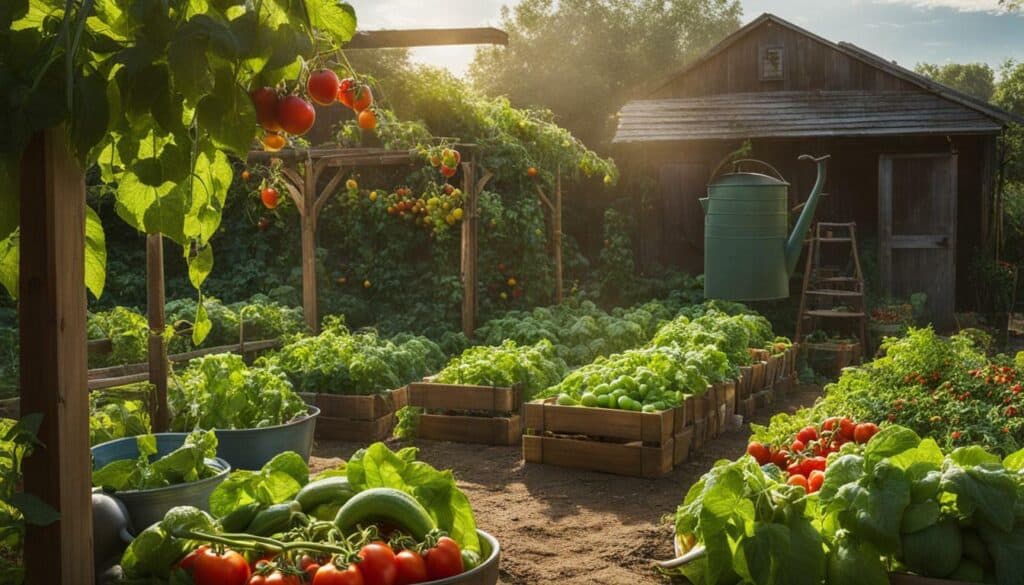
Gardening Ideas
- Grow a variety of vegetables that you and your family enjoy eating.
- Build raised garden beds to better control soil quality and drainage.
- Try container gardening for smaller spaces.
- Consider adding herbs to your vegetable garden for added flavor and aroma.
Get started on your vegetable gardening journey today and enjoy the delicious rewards of homegrown produce. Happy gardening!
Discover the Beauty of Flower Gardening
Flower gardening is a fulfilling and gratifying hobby that brings us closer to nature and allows us to create our own green oasis. Whether you have a small balcony or a large backyard, anyone can enjoy the beauty of flowers with the right knowledge and skills. Choosing the right plants is crucial, including vibrant annuals, long-lasting perennials, or biennials that take two years to complete their life cycle.
Soil preparation is essential to ensure a healthy and thriving garden. Conducting soil tests to determine nutrient levels and pH balance is crucial for successful gardening. Soil amendments such as compost, organic matter, and sand can improve soil fertility and structure, giving your plants the best possible chance to flourish and grow. It is important to follow proper techniques for planting seeds, seedlings, and potted plants to ensure that they have the right amount of space and light to grow.
Don’t forget about proper watering techniques, maintenance tips, fertilization, pruning, and pest control to keep your garden thriving throughout the season. When it comes to watering, it’s important to water deeply but not too often, allowing the soil to dry out slightly between watering. Fertilization and pruning are also important to promote plant growth and maintain overall health. Lastly, pest control is crucial to protect your flowers from unwanted visitors.
One of the most rewarding aspects of flower gardening is harvesting and enjoying the fruits of your labor. Whether you’re picking a bouquet for your kitchen table or enjoying the scent of fresh flowers in the air, flower gardening is a great way to connect with nature and bring beauty and joy to your daily life. With patience, observation, and a willingness to learn from mistakes, you can create a beautiful garden that will be the envy of your neighbors.
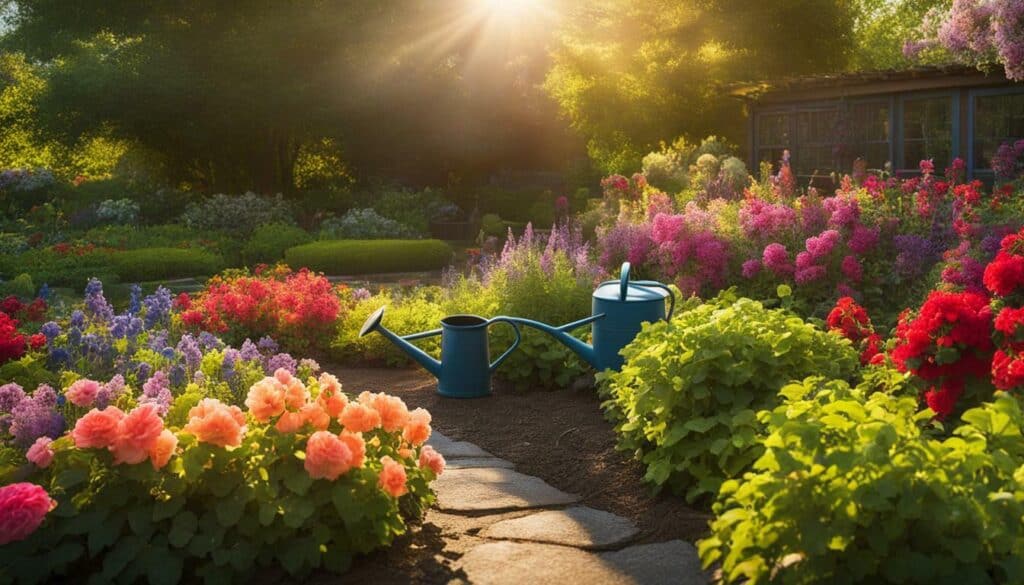
So why not unleash your green thumb and discover the beauty of flower gardening today? With the right tools, techniques, and enthusiasm, you too can create a stunning garden that will bring you joy for years to come.
Enjoy the Journey of General Gardening
And remember, gardening is an ongoing learning experience, so don’t be afraid to make mistakes and try new things. Enjoy the journey and watch your garden bloom!
Creating your own green oasis is a rewarding experience no matter how big or small your gardening space may be. The first step is choosing the right plants for your garden. Consider starting with vibrant annuals, long-lasting perennials, and biennials that take two years to complete their life cycle. These types of plants are suitable for beginners and can add beautiful color to your garden.
Preparing the soil is a crucial step to ensure healthy plant growth. Conduct a soil test to determine nutrient levels and pH balance, and use soil amendments like compost, organic matter, and sand to improve soil structure and fertility.
Once you have your plants and soil ready, follow proper planting techniques including spacing and watering to give your plants the best start. Remember that gardening is an ongoing journey that requires care and attention.
To keep your garden thriving, learn about watering techniques, maintenance tips, fertilization, pruning, and pest control. Regular care and attention will help your garden stay healthy and produce a bountiful harvest.
Embrace the learning experience, seek guidance from other gardeners, and don’t be afraid to make mistakes. Gardening is a journey that connects you with nature and brings joy and fulfillment.
FAQ
Q: What types of plants should I choose for my garden?
A: You can choose from annuals, perennials, or biennials depending on your preferences and gardening goals.
Q: How can I prepare my soil for a healthy garden?
A: Conduct a soil test to determine nutrient levels and pH balance. Add soil amendments like compost or organic matter to improve fertility and drainage.
Q: What are some proper watering techniques?
A: Water your garden with the right amount, water at the base of plants, and water in the morning or evening to reduce evaporation.
Q: How can I fertilize and prune my garden?
A: Use appropriate fertilizers for your plants and prune regularly to promote healthy growth and remove dead or damaged parts.
Q: How can I control pests in my garden?
A: Utilize organic gardening practices, such as companion planting and natural pest repellents, to keep pests at bay.
Q: What are some tips for indoor gardening?
A: Choose suitable plants for indoor conditions, provide adequate lighting, and follow proper care guidelines to create a thriving indoor garden.
Q: What should I know about vegetable gardening?
A: Discover the benefits of growing your own vegetables, get ideas for different types of vegetables to grow, and learn about proper care and maintenance.
Q: How can I create a beautiful flower garden?
A: Explore different types of flowers, get design inspiration, and learn how to care for your flower garden to achieve stunning blooms.
Q: Any final tips for general gardening?
A: Remember that gardening is an ongoing learning experience, so don’t be afraid to make mistakes and try new things. Enjoy the journey and watch your garden bloom!
Are General Gardening Tips Sufficient for a Beginner?
For beginners, general gardening tips may not be sufficient to gain confidence and knowledge. Taking beginners gardening courses can provide hands-on training, guidance, and a deeper understanding of essential gardening techniques. These courses offer valuable insights, practical skills, and personalized advice that can accelerate the learning process and help beginners become more successful gardeners.
Source Links
- https://www.thegoodlifeonstage.com/unleash-your-green-thumb-beginners-guide-to-gardening.htm
- https://gardensuperpower.com/unleashing-your-green-thumb-the-benefits-and-basics-of-starting-an-edible-garden/
- http://16.171.28.12/gardening-tips-for-beginners-cultivating-your-green-thumb/
- https://www.amazon.com/Green-Thumb-Garden-Guys-How-ebook/dp/B007TZMESA
- https://www.realhomes.com/advice/how-to-choose-plants-for-your-garden
- https://www.thespruce.com/plant-selection-for-the-landscape-2131865
- https://www.wikihow.life/Choose-Plants-for-a-Garden
- https://www.almanac.com/soil-preparation-how-do-you-prepare-garden-soil-planting
- https://hort.extension.wisc.edu/articles/beginning-vegetable-garden-basics-site-selection-and-soil-preparation/
- https://platthillnursery.com/best-tips-to-prepare-garden-soil/
- https://www.gardena.com/int/garden-life/garden-magazine/10-golden-rules-for-watering/
- https://www.bhg.com/gardening/yard/garden-care/watering-gardens/
- https://www.hgtv.com/outdoors/gardens/planting-and-maintenance/the-proper-way-to-water-your-garden
- https://fgsdurham.com/blog/pruning-fertilizing-basics/
- https://www.almanac.com/how-fertilize-your-vegetable-garden
- https://www.popularmechanics.com/home/lawn-garden/how-to/a9143/tree-tips-pruning-and-fertilizing-simplified-15610294/
- https://www.familyhandyman.com/article/homeowners-guide-to-garden-pest-control/
- https://www.gardenary.com/blog/5-ways-to-deal-with-garden-pests-naturally
- https://www.bhg.com/gardening/pests/insects-diseases-weeds/garden-pest-control/
- https://impakter.com/how-indoor-gardening-can-boost-our-mental-and-physical-health/
- https://www.ncbi.nlm.nih.gov/pmc/articles/PMC6334070/
- https://www.nbcnews.com/better/health/indoor-plants-can-instantly-boost-your-health-happiness-ncna781806
- https://content.ces.ncsu.edu/home-vegetable-gardening-a-quick-reference-guide
- https://www.gardeningknowhow.com/featuring/complete-guide-to-vegetable-gardening-everything-to-know-about-growing-veggies
- https://www.gardeningknowhow.com/edible/vegetables/vgen/vegetable-gardening-for-beginners.htm
- https://www.mainstreetseedandsupply.com/flower-gardening-tips-and-tricks-s/349.htm
- https://gardenerspath.com/general-flower-guides/
- https://ginghamgardens.com/flower-gardening-101/
- https://njaes.rutgers.edu/fs1211/
- https://www.gardenersworld.com/how-to/grow-plants/gardening-for-beginners-10-tips/
- https://www.betterhealth.vic.gov.au/health/healthyliving/gardens-for-all-a-health-activity





Leave a Reply